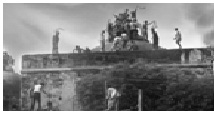 ON December 6, 1992, a disputed structure standing in the city of Ayodhya, came crashing down. It remains even today a traumatic event for the nation, because modern Indians have not yet been weaned on a true history of India but on Macaulayian version view the destruction of the structure as criminal vandalism.
ON December 6, 1992, a disputed structure standing in the city of Ayodhya, came crashing down. It remains even today a traumatic event for the nation, because modern Indians have not yet been weaned on a true history of India but on Macaulayian version view the destruction of the structure as criminal vandalism.
However, the real act of vandalism was the superstructure built on a hoary and existing temple, and the vandals came from abroad to demolish the temple, and to build a mosque on the same spot.
Could the disputed structure demolition on December 6, 1992 have been avoided ?Two years earlier before the demolition, by a coincidence, on the same month and day, I had met representatives of the VHP and BJP at a house, next door to mine, on Mathura Road. The newly sworn in Prime Minister Chandrashekhar had asked me [I was then his newly sworn in senior most Cabinet Minister] as the new Union Law & Justice Minister, I should talk to them about withdrawing their proposed massive nation-wide stir slated to begin on December 9, 1990 for building Sri Ram temple at the site the super-structure that had then stood in its gloomy glory. The Prime Minister told me to assure the VHP that our government would get removed the disputed structure with the consent of Muslim leaders through discussions.
The VHP and BJP leaders I met readily agreed to call off the stir since we were a new government, while the stir decision was taken when VP Singh was PM.
Thereafter in January 1991 talks began initiated by Chandrashekhar himself with the Muslim leaders. Unfortunately, despite progress in the talks, our government did not last long enough to fructify it.
Had instead the government lasted for a year more, I am confident we would have amicably liberated the Sri Ram janmabhoomi for building a befitting Sri Ram temple, and with the consent of the Muslim community, even though the Government was in the minority in the Parliament.
From my personal experience as a Minister in a minority government, I can therefore say that lack of majority is no excuse for implementing any agenda, if the leadership had the mindset to get things done.
As a Minister of Law &Justice, for instance, I got the controversial Sessions Judge of Faizabad, KM Pandey made a High Court judge, despite the fact that the previous VP Singh’s “three-legged” government had issued orders on file that since Pandey had directed the locks on the so-called disputed structure be removed in 1986, he should never be made a High Court judge.
Mulayam Singh was our Chief Minister of UP, and thoroughly opposed to Pandey, but with firmness I however got his protests sufficiently moderated to him permitting me to go ahead. He cooperated because he knew I would do it anyway— make Pandey a judge of the High Court—and hence he acquiesced since he wanted other things done for him by me.
The same clarity enabled the Chandrashekhar government to get Saifuddin Soz’s kidnapped daughter freed without releasing any dreaded terrorists. There are methods for doing that—mostly based on retaliation and not negotiation. In each such case it is the mindset of those elected to high office that matters, not the size of the parliamentary majority or lack of it.
It was this mindset that enabled the Chandrashekhar government to nearly solve by an agreement the question of building of a Sri Ram temple in Ayodhya. The government however fell before it could be clinched.
But can a masjid be demolished in legally authorised way? The Supreme Court has held in the Faruqui vs. Union of India case [(1994)6 SCC360], that a masjid is not an essential part of Islamic theology, and these can and have been be demolished for public good.
Saudi Arabia, Pakistan, and even in British undivided India, masjids have demolished mosques to build roads. Saudi Arabia even demolished the Bilal Masjid in Mecca where Prophet Muhammed used to read namaz, to build a palace for the Sheikhs.
Masjids, like churches, are not religious places in the sense a temple is. Masjids and Churches are places not of, but for worship, i.e., buildings which serve as facilitation centres for namaz and prayer. Namaz can be read anywhere even on a railway platform. In USA, VHP buys disused churches and converts them into temples, and yet no Christian there objects.
But temples, once it is shown that prana prathista puja is performed to build it, is where God or deity resides, and therefore a temple belongs to God forever. As Union Law & Justice Minister in 1991 I got our government’s legal team to prove this to the satisfaction of the House of Lords in Britain, to bring back a Nataraja statue taken from a disused Thanjavur temple.














Comments